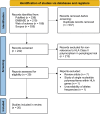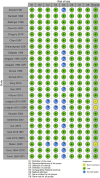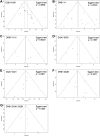Association of HLA class II alleles and haplotypes with bullous and mucus membrane pemphigoid risk: A systematic review, a meta-analysis and a meta-regression
- PMID: 39442009
- PMCID: PMC11503847
- DOI: 10.1177/03946320241296903
Association of HLA class II alleles and haplotypes with bullous and mucus membrane pemphigoid risk: A systematic review, a meta-analysis and a meta-regression
Abstract
Although, several studies have assessed the association of HLA Class II and genes with bullous pemphigoid (BP) and mucous membrane pemphigoid (MMP), results were inconsistent and between-studies heterogeneity needs to be investigated. An electronic literature search for eligible studies among all papers published prior to May 31, 2024, was conducted through PubMed, EMBASE, Web of science and Scopus databases. Meta-analyses together with subgroup analyses and meta-regressions were performed for the three following HLA genes: DRB1, DQA1 and DQB1. Combined analyses revealed a significant increase in pemphigoid risk conferred by the following alleles: DQB1*0301, DRB1*11, DRB1*1101 subtype and DQA1*0505, all p-values <.001. However, there was a moderate to high level of between-studies heterogeneity. Subgroup analyses revealed that the risk conferred by the aforementioned alleles was significantly higher in case of dipeptidyl peptidase-4 inhibitors induced BP (DBP) comparatively to idiopathic BP and MMP. In addition, the risk conferred by the DQB1*0301 was significantly higher in MMP (OR [95% CI] = 5.25 [4.03-6.84]) than in BP (OR [95% CI] = 2.22 [1.87-2.65]), p = .007. Besides, the DRB1*1101-DQB1*0301 and DRB1*11-DQA1*05-DQB1*0301 haplotypes were significantly associated with an increased pemphigoid risk, both p-values <.001. Conversely, the DQA1*0201 allele was significantly associated with reduced pemphigoid risk (OR [95% CI] = 0.3 [0.17-0.52]), with no between-studies heterogeneity (I2 = 0%, p = .76). This meta-analysis demonstrated that the DRB1*1101, DQA1*0505 and DQB1*0301 were significantly associated with increased pemphigoid risk. These associations were found to be significantly stronger in case of DBP comparatively to idiopathic pemphigoid. The DQA1*0201 allele seems to play a protective role against pemphigoid. Registration: This review has been registered on PROSPERO: CRD42024552821, Available from: https://www.crd.york.ac.uk/prospero/display_record.php?ID=CRD42024552821.
Keywords: HLA class II; bullous pemphigoid; haplotype; meta-analysis; meta-regression; mucous membrane pemphigoid.
Conflict of interest statement
Declaration of conflicting interestsThe author(s) declared no potential conflicts of interest with respect to the research, authorship, and/or publication of this article.
Figures















References
-
- Yang W, Cai X, Zhang S, et al. (2021) Dipeptidyl peptidase-4 inhibitor treatment and the risk of bullous pemphigoid and skin-related adverse events: a systematic review and meta-analysis of randomized controlled trials. Diabetes/ Metabolism Research and Reviews 37(3): e3391. DOI: 10.1002/dmrr.3391. - DOI - PubMed
Publication types
MeSH terms
Substances
LinkOut - more resources
Full Text Sources
Medical
Research Materials

